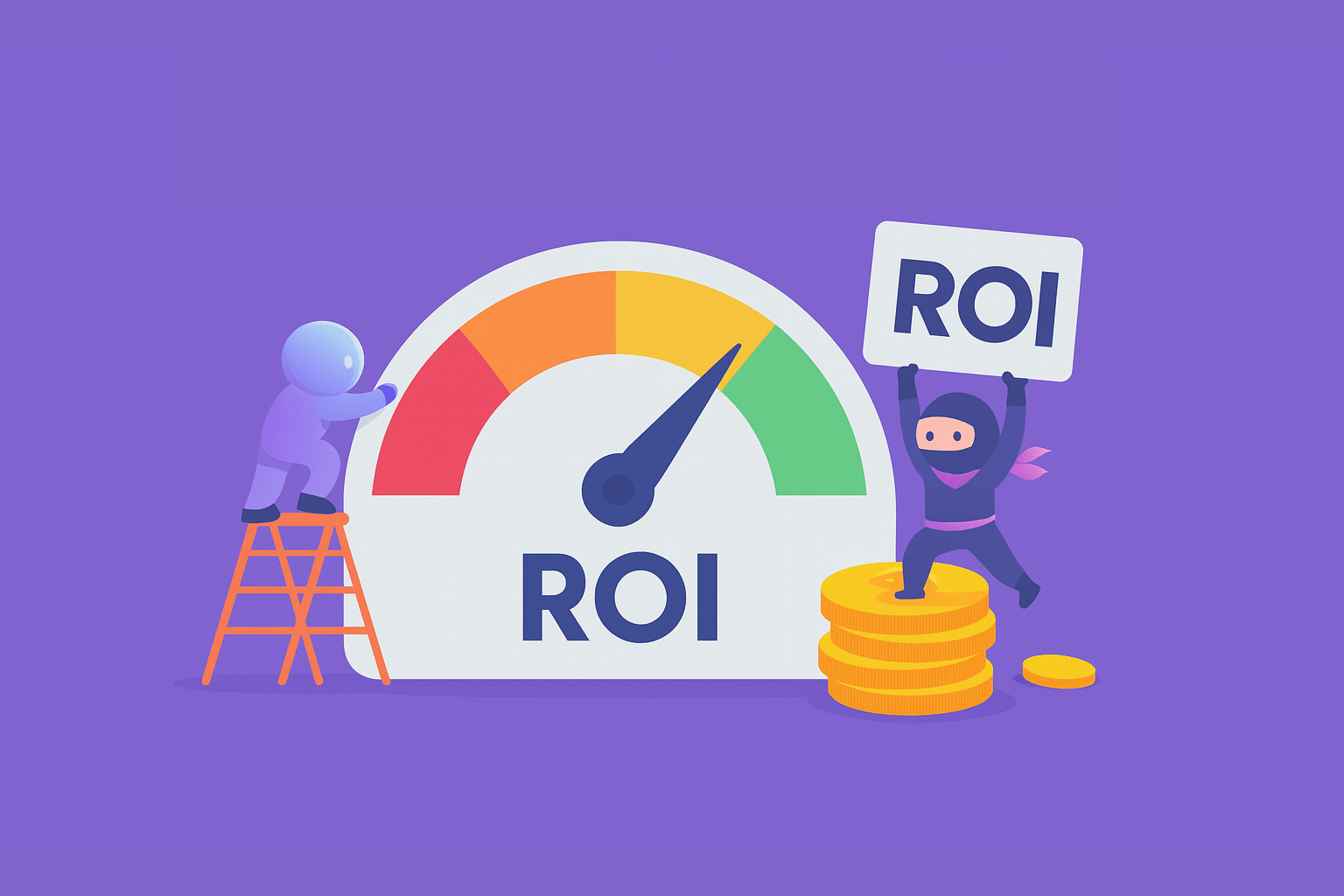What if unlocking the secrets of SEO ROI could breathe new life into your business’s online approach? Picture yourself finally seeing, in plain numbers, how your search engine efforts are working—and using that knowledge to steer your next move. Tracking the payoff from your SEO is more important than ever; let’s break down what really moves the needle, so you can make smarter decisions and get more from your investment.
Table of Contents
Understanding SEO ROI
What is SEO ROI?
SEO ROI is simple at its core: it’s the money you earn compared to what you spend on search engine efforts. To make this real, think of a company like Moz that tracked its SEO spending and results—focusing on quality content and technical tweaks, they saw clear financial gains. Why does this matter? When you know your SEO ROI, it’s much easier to decide where your time and budget should go next.
If you put in $1,000 and bring in $3,000, that’s a 200% ROI—a pretty straightforward way to see success. Calculating this means tallying every SEO expense, from tools and salaries to new blog posts, and weighing those costs against the revenue your SEO brings in.
Why SEO ROI Matters
Smart budget decisions hinge on knowing your SEO ROI. A HubSpot study found that businesses focusing on search see a return of $2.75 for every $1 spent; that’s not pocket change. This kind of clarity lets companies shift gears fast, making sure that their marketing actually pays the bills and sparks real growth.
Suggested Readings:
What is SEO ROI & How to Measure it?
The Importance of SEO ROI in Digital Marketing
Common Myths About SEO ROI
Many folks think tracking SEO ROI is only for big players or that it’s just too complicated. The truth? With today’s tools, even a small team can measure and improve their ROI. Setting clear targets and watching the right data points will let you bust this myth and see results, no matter your company’s size. Ready to see how? Let’s keep going.
Setting Clear SEO Objectives
Aligning SEO With Business Goals
To get the most from SEO, your goals need to fit your bigger business aims. That means figuring out how SEO can help you hit targets like more sales or a stronger reputation, then steering your strategy to match. When your search efforts and business plans work together, you create a strategy that actually moves the dial.
Say your goal is to grow sales by 20% this quarter. Your SEO target might be a 30% boost in organic visitors. With sharp, trackable goals like that, you can measure progress and adapt your plan as you go.
Identifying Key Performance Indicators
Which KPIs matter most for SEO? Start with a few:
- Organic traffic
- Conversion rates
- Revenue generated from organic search
Each tells a different part of the story. Choose what matches your aims, and track both short-term wins and longer-term patterns for a fuller picture.
For an online shop, revenue from organic search may be your north star. But you’ll want to watch conversion rates and order size too. By regularly checking these, you see exactly how search tweaks affect your bottom line.
Establishing Baseline Metrics
You can’t measure progress if you don’t know where you started. Baseline metrics are your starting line—drawn from old data or industry averages. Check them often, since the marketplace and your goals can change fast. With good baselines, you’ll spot what’s working and what needs work, and we’ll look at practical tracking tools in just a bit.

Tracking the Right SEO Metrics
Organic Traffic Growth
Organic traffic isn’t just a vanity number—it connects directly to sales and conversions. By monitoring it with analytics tools, you can spot trends and tweak content or keywords if numbers drop. Imagine a business that gets a 25% traffic bump after making its site mobile-friendly; that’s proof in the pudding that SEO work pays off.
With smart tracking, you’ll know exactly which changes bring more eyes—and wallets—to your site.
Conversion Rate Tracking
Conversion rates show how well your SEO turns visitors into customers. With the right setup in your analytics, you’ll see where your site shines and where it stumbles. If a landing page isn’t working, try revamping copy or smoothing out the user journey; sometimes, a small tweak is all it takes to move the needle.
Revenue Attribution Methods
Revenue attribution tells you which pieces of your marketing pie are actually driving income. Are people buying after their first visit, or after seeing you five times? Models like last-click and multi-touch show different stories. Knowing which fits your business best helps you spend smarter and squeeze more from your SEO dollars.
Calculating SEO ROI Effectively
SEO ROI Calculation Formula
The math of Return on Investment is simple: (Gain from Investment – Cost of Investment) / Cost of Investment. The trick is making sure you’re crediting SEO for the results it actually earns—watch out for model quirks that can cloud the picture. For example, if your SEO budget is $1,000, you earn $3,000, and your net cost is $500, plug that into the formula to see where you stand. Practical, isn’t it?
Tools for Measuring SEO ROI
Several tools help you measure SEO ROI, from analytics dashboards to spreadsheets. Each has strengths and blind spots, so mix and match as needed. Google Analytics tracks visits and sales, while a trusty spreadsheet can help crunch the numbers. The best approach? Pull data from all corners for a full view. You can also try SERPed.net's SEO ROI Calculator to quickly estimate returns on your campaigns and see if your efforts are truly paying off.
Challenges in SEO ROI Calculation
Measuring ROI isn’t always a walk in the park. It’s tough to tell which clicks turn into sales, and messy data can muddy the waters. Using advanced analytics and spot-checking your numbers can help you trust your results. Tools like Google Tag Manager and sampling methods can keep your data honest and actionable.

Factors Impacting SEO ROI
Website Structure and User Experience
How your website is built—and how people feel using it—has a huge impact on SEO ROI. If visitors can’t find what they want fast, they’re gone. Make your site mobile-friendly, speed up loading, and streamline navigation; you’ll see happier visitors and more sales as a result.
Content Quality and Relevance
Content that’s fresh, helpful, and truly relevant keeps folks reading and coming back. Regularly audit your pages to spot what’s stale, then update or expand as needed. A good content refresh can turn a slow performer into a silent workhorse.
Link Profile and Authority
If search engines see your site as trustworthy, you climb the rankings—and that means more ROI. Build your link profile with outreach, smart content, and partnerships. Tools like SERPed.net make tracking links a breeze; try guest posting to get quality sites sending visitors your way.
Calculate Your SEO ROI Now
Use our SEO ROI Calculator to estimate the revenue potential of your SEO campaign!
Optimizing On-Page Elements for Higher ROI
Title Tags and Meta Descriptions
Titles and meta descriptions may seem small, but they pack a punch for SEO. Well-written, keyword-smart tags entice clicks from search results and improve user relevance. With tools like SERPed.net, you can spot weak spots and sharpen your titles for better results.
Internal Linking Strategies
A thoughtful internal linking plan helps both users and search engines explore your site. Use analysis tools to find pages that need a boost or are getting buried. By connecting content in meaningful ways, you make your site more navigable and boost valuable pages.
Mobile-Friendliness and Speed
People expect sites to work smoothly on their phones and load fast. Google PageSpeed Insights will show you where you lag. Optimize for mobile, trim unnecessary code or images, and watch both your traffic—and your ROI—climb.
Leveraging Off-Page SEO for ROI
Earning Quality Backlinks
The right backlinks can open doors to new audiences and higher rankings. Whether through guest posts, being listed as a resource, or fixing broken links, aim for quality over quantity. SERPed.net can help you track your progress and spot fresh opportunities for outreach.
Building Brand Mentions
When others mention your brand online, your credibility grows. Tools like Brand24 let you keep tabs on these mentions. By reaching out to those who mention you and nurturing these relationships, you can turn curiosity into clicks and sales.
Social Signals and SEO
Social likes and shares may not directly move your search rankings, but they drive visits and engagement. Manage your presence with tools like Hootsuite, and promote your most valuable content; sometimes a single viral post jumpstarts a whole new wave of traffic.
Improving Content Strategy to Boost SEO ROI
Keyword Research and Targeting
Smart keyword research lays the foundation for every winning content plan. Use Google Keyword Planner to find terms that matter to your audience, then craft content that answers their questions. The payoff: more targeted visits and better conversion chances.
Updating Existing Content
Don’t let your best content gather dust. Audit your site with SERPed.net or a similar tool, prioritize updates, and refresh as needed. Sometimes, a minor update can breathe new life into an old post and capture new search interest.
Content Promotion Techniques
Promotion matters as much as creation. Use platforms like BuzzStream to manage your outreach, share on the right networks, and connect with influencers. When your content gets in front of new eyes, your SEO efforts pay off in spades.
Monitoring and Reporting SEO ROI
Creating SEO ROI Dashboards
Dashboards bring all your key SEO data into one place, making it easier to spot trends and act fast. Google Data Studio is a popular pick for custom views. By pulling in the right metrics, you get a clear snapshot of what’s working right now.
Interpreting SEO Reports
Reading SEO reports is more than glancing at numbers—you’re looking for patterns and turning data into practical steps. Presenting these insights clearly makes it easier to keep your team and stakeholders on board. If you can tell a story with your numbers, you’re halfway to buy-in.
Adjusting Strategies Based on Data
SEO isn’t set-and-forget. Regularly review your analytics, test new ideas, and refine your approach based on what works. Whether it’s tweaking content or shifting your budget, letting data guide your efforts keeps your strategy sharp and adaptable.

Common Mistakes That Hurt SEO ROI
Ignoring Technical SEO
Skipping technical SEO invites trouble: slow pages, missing redirects, and duplicate content all hurt your ranking and ROI. Tools like Screaming Frog help diagnose issues. Fixing these technical snags is often the difference between being found and being forgotten.
Neglecting User Intent
If your content doesn’t match what users are really searching for, your conversion rates will suffer. Dive into tools like Google Trends to find out what your audience wants. Align your content, and you’ll see better engagement and results.
Overlooking Local SEO Opportunities
Missing out on local SEO is like leaving money on the table—especially for businesses with a physical presence. Google My Business helps you get noticed by customers nearby. Local optimization steps can transform local search into a reliable revenue stream.
Conclusion and Key Takeaways
Improving SEO ROI isn’t about a single trick—it’s about weaving together technical fixes, content upgrades, and smart promotion. By knowing what drives results and tracking progress over time, you’ll see where your efforts pay off and where to push harder. Keep a close eye on metrics, adapt as you learn, and your SEO will become a true business asset.
So, what’s next for you? Take a hard look at your current strategy, pinpoint what’s lagging, and use these tactics to make meaningful improvements. With patience, focus, and a little grit, you can see your investment in SEO pay off—and maybe even surprise yourself with how far you can go.


